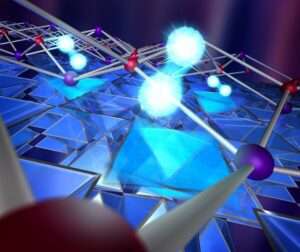A groundbreaking research effort has successfully simulated super diffusion using a state-of-the-art quantum computer. This achievement marks a significant advancement in our understanding of quantum phenomena and their potential applications.

In a remarkable development, a dedicated research team has harnessed the power of a quantum computer to simulate super diffusion, a complex process that occurs at the quantum level. This breakthrough opens new avenues for exploring quantum mechanics and its real-world implications.
Super diffusion, a phenomenon that goes beyond classical diffusion, involves particles spreading at an accelerated rate. This intricate behavior has intrigued scientists for years, and simulating it on a quantum computer provides valuable insights into the underlying mechanisms.
The research team leveraged cutting-edge quantum computing technology to replicate and analyze super diffusion in a controlled environment. By meticulously designing quantum algorithms and harnessing the unique properties of quantum bits (qubits), they achieved an accurate simulation that mirrors the intricate behavior of super diffusion.
This accomplishment has far-reaching implications across various scientific disciplines. Understanding super diffusion has potential applications in fields such as material science, cryptography, and even optimization problems. The ability to simulate such intricate quantum processes brings us closer to unlocking the full potential of quantum computing.

The successful simulation of super diffusion on a quantum computer demonstrates the remarkable capabilities of this technology and its role in advancing our knowledge of quantum mechanics. As quantum computing continues to evolve, researchers are poised to explore even more complex phenomena, paving the way for revolutionary breakthroughs in science and technology.
This achievement also underscores the collaborative nature of scientific progress, as researchers from diverse backgrounds come together to tackle complex challenges. By pushing the boundaries of quantum computing, this research team has opened a new chapter in our exploration of the quantum realm.

This accomplishment marks the initial stride toward tackling intricate quantum transport calculations utilizing quantum hardware. As hardware advances over time, this endeavor holds the potential to illuminate new insights in the realms of condensed matter physics and materials science.
The quantum computer employed in this study during its nascent phase is composed of 27 superconducting qubits, the fundamental building blocks of quantum logic. This computational setup is physically situated within IBM’s facility in Yorktown Heights, New York, while being remotely programmed from Dublin.

Elucidating the significance of their work and the overarching concept of quantum simulation, Professor John Goold, the director of the recently established Trinity Quantum Alliance who spearheaded the research, expounds, “In essence, the challenge of simulating the dynamics of a complex quantum system with numerous interacting components poses a formidable hurdle for classical computers.”
“As the system scales, suppose we expand it to encompass 300 qubits; the requisite coefficients would surpass the total number of atoms within the observable universe, making an exact description of such a system unattainable for classical computers. In essence, we encounter an insurmountable obstacle when endeavoring to simulate quantum systems of this magnitude,” Goold elaborated.

So, what precisely did the team simulate? Professor Goold elaborates, “Among the simplest non-trivial quantum systems reside spin chains. These entail networks of interconnected magnets known as spins, emulating more intricate materials and serving as models to comprehend magnetism. Our interest gravitated toward a model christened the Heisenberg chain, with a specific focus on discerning the long-term behavior of spin excitations traversing the system. As these quantum many-body systems transcend to extended timeframes, they embrace a hydrodynamic regime, governed by equations akin to those dictating classical fluids.”

The simulation of super diffusion on a quantum computer represents a significant milestone in quantum research. This accomplishment not only deepens our understanding of quantum phenomena but also highlights the immense potential of quantum computing in solving complex problems and driving innovation across various industries.
